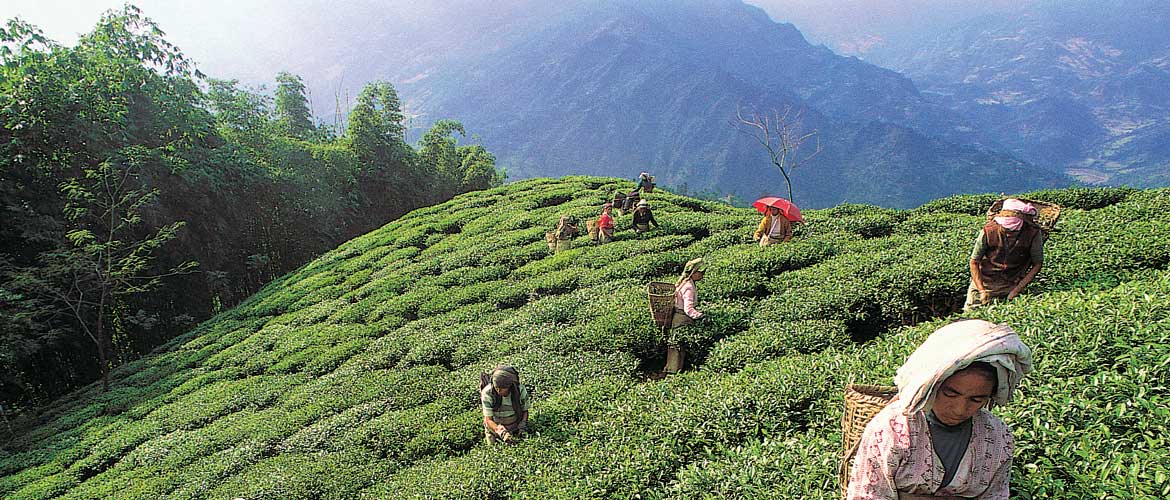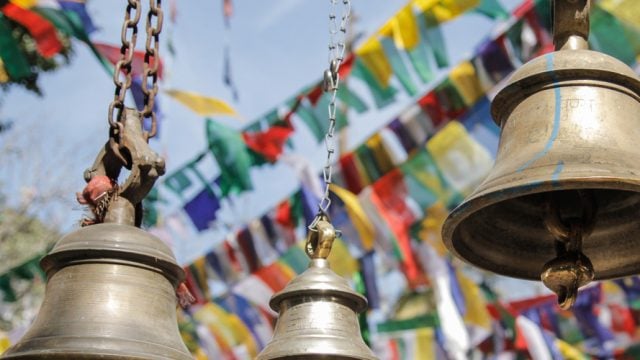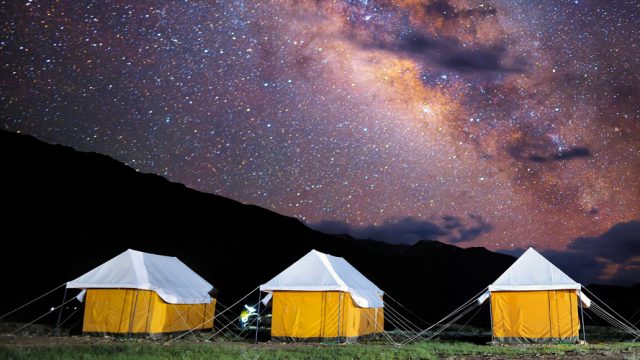In its formative years Darjeeling was a scattered village of English cottages. Because of its
THINGS TO SEE AND DO
Darjeeling is a town made for long walks, situated over a ridge and spilling down the hillside in a series of interconnecting roads. You’ll come across a lot of colonial architecture – English cottages with antiquated windows and smoking chimneys, magnificent school buildings and churches. Chowrasta, the main town square, is lined with shops, restaurants and hawkers. Whether you notice it or not, Khangchendzonga, the third highest peak in the world, is omnipresent. Each morning, tourists head to Tiger Hill to see what was reckoned by many to be, at least from 1838 to 1849, the highest mountain in the world – Kangchendzonga. Then, in 1856, the Survey of India confirmed the suspicion that actually Nepal’s Sagarmatha, named Everest by the British, was it. The difference in their height is a mere 826ft.

The Yiga Choeling Tibetan Monastery of the Gelugpa (Yellow Hat) sect is located near Tiger Hill. It is also called the Ghoom Monastery, probably came up in 1850 but the foundation date is commonly stated as 1875. Besides the 15-ft-high Maitreya Buddha, check out the beautiful thangkas on the walls. The monastery is also a storehouse of Tibetan translations of famous Sanskrit works, such as the Meghdoot by Kalidasa, Nagamandala by Sriharsa and Nyaya Krit by Dharmakriti.
The Bhutia Basti is the oldest monastery in Darjeeling. It’s an unusual blend of Tibeto-Nepalese architecture and a storehouse of rare artefacts, including ancient Buddhist texts.
The Himalayan Mountaineering Institute was established in 1954, a year after Everest was scaled. Tenzing Norgay, one of the first two individuals known to reach the summit of Mount Everest, was the director of this institute for many years. The Mountaineering Museum here has interesting displays and records of some major expeditions. The Everest Museum, traces the history of different attempts on Everest. The institute also organises mountaineering courses. Rock climbing lessons can be taken at the Tenzing Norgay Rock, located on the northern fringes of Darjeeling.
The Padmaja Naidu Himalayan Zoological Park is known internationally for its successful breeding programmes of the endangered snow leopard and the red panda. You will also see the rare Siberian tiger and Tibetan wolves here.

Darjeeling also has some lovely gardens and parks. Behind the Raj Bhavan is the Shrubbery (which was once the summer home of the Maharaja of Cooch Behar), a garden with a view of Kangchendzonga and the Singalila Valley. The Lloyd Botanical Gardens house Himalayan and alpine plant varieties. The hothouse has more than 50 species of orchids.
When built in the late 19th century, the Darjeeling Himalayan Railway was something of a technological marvel. Its tracks rose from sea level to an altitude of 7,545ft in just about 70km. The engineers devised many zigzags, reverses and loops to overcome these gradients, but the most famous one is the Batasia Loop, where the train does a complete figure-of-eight along the track. If you haven’t taken this train — today a UNESCO World Heritage Site — up to Darjeeling, you can always take a short joyride from Darjeeling Station to Ghoom Monastery.
Darjeeling Tea
Dr Campbell, the first superintendent of Darjeeling, planted the first seeds in his garden sometime in the late 1830s or 1840s. The first seeds were from Chinese hybrid bushes brought from the Kumaon Hills, but gradually these strains metamorphosed into what is now known as ‘Darjeeling Tea’. In 1886, one TT Cooper estimated that Tibet consumed 60,00,000 lbs of Chinese brick tea annually. Cooper suggested that if this could be replaced by tea supplied from India, it promised a market of great value. The rest, as we know, is history. Today, there are some 87 tea estates in and around Darjeeling, employing over 50,000 people. Among the best tea is ‘first flush superfine tippy golden flowery orange Pekoe’. Prices range from ₹380–25,000 per kg. Nathmull’s on the Mall is a good outlet.

WHERE TO STAY
The Windamere Hotel (Tel: 0354- 2254041; Tariff: ₹15,745–30,000), on top of Observatory Hill, is the place to stay. In time-honoured tradition, afternoon tea is served in the drawing room. The full course dinner is legendary. The Elgin (Tel: 2257226/ 27, Kolkata Tel: 033- 40646300, 22269878, 2265103; Tariff: ₹9,050–10,650), a 120-year-old hotel, is also among Darjeeling’s oldest and finest. The Cedar Inn (Tel: 2254446; Tariff: ₹10,300–18,400) is near St Paul’s. Planter’s Club (Tel: 2254348/ 49) is the old Darjeeling Club converted into a hotel; it is currently being renovated. Other options are Hotel Mohit (Tel: 2254818; Tariff: ₹4,000–5,200), Hotel Seven Seventeen (Tel: 2255099, 2254717, 2252017; Tariff: ₹2,500–3,800), the Darjeeling Bellevue Hotel (Tel: 2254075, Cell: 09800667148; Tariff: ₹1,600–4,500) and Sinclairs (Tel: 2256431/ 32; Tariff: ₹4,800–7,000).
WHERE TO EAT
Keventer’s, opposite Planter’s Club, is known for its breakfast spreads, especially cold cuts. Though Penang looks slightly seedy, it has superb Tibetan food. For thukpas, momos and unforgettable chilli chutney, try Dekevas. Glenary’s homemade chocolates, èclairs, cakes, and breads are excellent. Kunga is a good place for local cuisine. If you love good tea, Nathmulls Tea Bar is the place.
GETTING THERE
Air Nearest airport: Bagdogra (91km/ 3.5hrs) connected to Delhi, Kolkata and Guwahati. A taxi to Darjeeling costs approx ₹2,500
Rail Nearest railhead: New Jalpaiguri (88km/ 3.5hrs) connected to Kolkata, New Delhi, Guwahati and Dibrugarh by Rajdhanis and Express trains. Toy train runs daily from New Jalpaiguri to Darjeeling (8–9 hrs); the service gets disrupted during the monsoons. Taxi costs approx ₹2,500
Road From Kolkata, it’s a long, 18-hr drive and can be done only with a night halt. From Siliguri, the 81-km drive on NH 55 to Darjeeling passes through Rongtong, Kurseong and Ghoom Bus Deluxe, AC and ‘Rocket’ buses from Dharamtala in Kolkata, will take you as far as Siliguri. From here, a Maruti Van to Darjeeling would cost ₹1,600, shared taxi ₹130
Dipankar Ghose
West Bengal
hill stations





